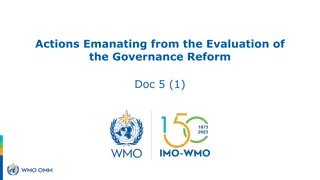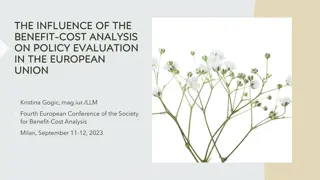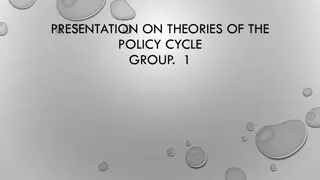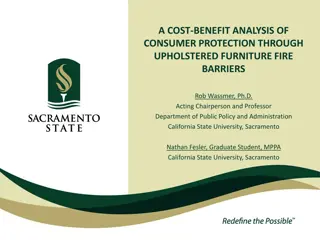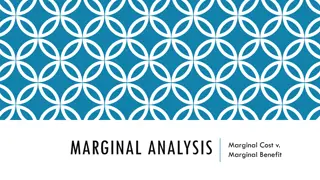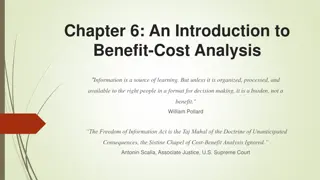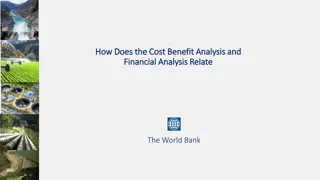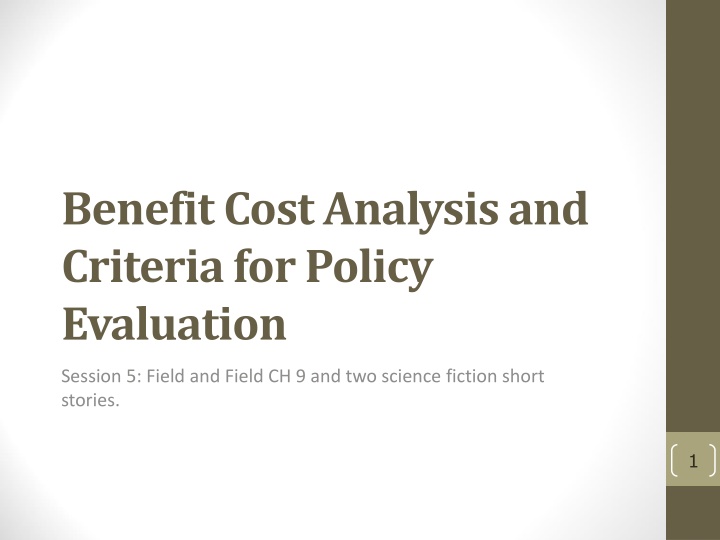
Policy Evaluation and Benefit-cost Analysis Session: Field Insights and Sci-fi Stories
Explore the concepts of benefit and cost analysis, criteria for policy evaluation, and environmental policy assessments. Learn to measure benefits from damage cost reduction, understand categories of cost, and calculate present value. Delve into the effects of pollution on production costs and agricultural and commercial losses. Gain insights into intergenerational discounting and methodological differences in financial, social, and intergenerational discounting.
Download Presentation

Please find below an Image/Link to download the presentation.
The content on the website is provided AS IS for your information and personal use only. It may not be sold, licensed, or shared on other websites without obtaining consent from the author. If you encounter any issues during the download, it is possible that the publisher has removed the file from their server.
You are allowed to download the files provided on this website for personal or commercial use, subject to the condition that they are used lawfully. All files are the property of their respective owners.
The content on the website is provided AS IS for your information and personal use only. It may not be sold, licensed, or shared on other websites without obtaining consent from the author.
E N D
Presentation Transcript
Benefit Cost Analysis and Criteria for Policy Evaluation Session 5: Field and Field CH 9 and two science fiction short stories. 1
Learning Objectives Understand categories of benefit Understand categories of cost Calculate and interpret present value / net present value Use PV / NPV for financial discounting of private investment Use PV / NPV for social discounting of public projects and programs with appropriate assumptions Concept of intergenerational discounting of long-term public projects and programs with appropriate assumptions Understand methodological differences and social implications of differences among financial, social and intergenerational discounting Criteria for Environmental Policy Evaluation 2
Benefits Benefits are gains from environmental improvement such as reduction of damage costs Calculating benefits from damage cost reduction Measure emissions Determine levels of ambient quality from emissions Estimate human exposure to ambient quality Estimate physical impact on humans of ambient quality Estimate value in currency of physical impact 3
Measuring Damage Costs Directly Health Costs Direct expenses such as prescription costs, inpatient care, outpatient care, office visits, etc. Indirect expenses such as lost time at work, employer cost of absence Does not include value of time lost that is not compensated such as retirees, homemakers, etc. Does include the amount people are willing to pay to avoid illness. Benefits are reduction in damages. This slide is about benefits, not costs. Costs are what we spend to reduce damage. 4
Measuring Damage Costs Directly Effects of pollution on production costs Agricultural loss such as livestock loss, crop yield loss, timber loss, resource deterioration (water quality, soil contamination) Commercial loss such as machinery maintenance and repair, facility repair, building deterioration, employee costs We must use net effects. Include change in producer surplus Do not include change in revenue. Why? 6
Limitations of Direct Measurement of Damages Monetary damages tend to be measured more easily. Non-monetized damages are often not included. Example: How do we determine loss of family services? Losses accrued to people who have no legal claim. Environmental damage may cause a market reaction that makes us underestimate or overestimate damage. Averting behaviour to avoid effects of damage may mask some of the damage. 8
Willingness to Pay: Estimation How much are we willing to pay to reverse or avoid damage? Revealed Preferences Averting costs: the expenses we incur to reduce and mitigate damage in a situation where will experience it. Price differentials: what is the price difference between situations with and without exposure to the damage? Stated Preferences Contingent valuation: carefully structured surveys. 9
WTP: Averting Costs How much are we willing to pay to mitigate the damage? Averting costs: the expenses we incur to reduce and mitigate damage Examples Rustproofing a vehicle Soundproofing a house Building a privacy fence 10
WTP: Hedonic Price Differentials Estimate what people pay for environmental characteristics. What is the price premium for Houses in a quieter/cleaner/safer neighborhood. Houses with a view. Houses near an amenity. What is the wage difference in a bad neighborhood In an air conditioned office In a resort city 11
WTP: Travel Cost Pricing How much will people pay to travel to a nice place? What is the Grand Canyon worth? What is Machu Picchu worth? We must be careful to recognize that this ignores non-use value, but it does tell us something important about the value of uniqueness. 12
Value of Human Life using Wages Value of a statistical life vs. value of a specific life We need to clarify what we are measuring. We are estimating the value of a hypothetical life Assuming we do not know who it is. Assuming people correctly assess risk. We are not equating this to the price of taking a specific life. What probability of death will you risk to save 15 minutes? How you drive helps answers this question! What probability of death will you risk to earn $10,000? Wages and occupational mortality risk helps answer this. 13
WTP: Stated Preferences Contingent Valuation (not for amateurs!) How do we ask people about WTP and get honest, thoughtful answers? Simple surveys seems obvious but Anchoring problem: do they have any idea? Cynicism: they think we will try to sell. We can offer alternative scenarios with prices. We can write a referendum question with tax. 15
WTP vs. WTA If your marginal benefit for a good is 30 EURO and you are offered 31 EURO, do you sell the good? Theoretically, willingness to pay and willingness to accept should be almost equal. Psychology research says this is not true. Predictably Irrational Dan Arielly. College basketball tickets Option value, existence value, bequest value and stewardship value play a part to create a wedge between WTP and WTA. 16
Costs: Direct and Indirect Costs are all opportunity costs of environmental improvement Direct costs of environmental improvement project Reporting and Compliance Regulatory cost of improvement Indirect economic impacts of project Effects on local industry Effects on labor market and regional economy Macroeconomic multiplier effects Why is opportunity cost an important issue? With/Without vs. Before/After Must consider replacing a prior action with a new action What else could we do with the resources? How might unintended consequences reverse the gains? 17
Costs: Basis for Comparison Compare Before and After regulation or Compare With and Without regulation? What s the difference? Must consider replacing a prior action with a new action Holding everything else constant 19
Financial Cost Benefit Analysis ? For a single period ?? = (1+?) For multiple periods, from now until time T ? ?? ?? = (1 + ?)? ?=0 Net present value includes both Benefits and Costs ? ?? ?? (1 + ?)? ??? = ?=0 All numbers must be either nominal or real, no mixing! 21
Financial Cost Benefit Analysis ? Project begins now, lasts three more years. Assume r=.08, Costs: 5000, 5000, 2000, 0 Benefits: 0, 0, 6000, 7500 What is the NPV? Is this worth undertaking? ?? ?? (1 + ?)? ??? = ?=0 22
How does timing matter? r t 0 1 2 3 C B 0 0 B-C Discount -5000 -5000 PV(B-C) 0,08 0,08 0,08 0,08 5000 5000 2000 6000 4000 0 7500 7500 1,0000 -5 000,00 0,9259 -4 629,63 0,8573 3 429,36 0,7938 5 953,74 NPV 1500 -246,53 r t 0 1 2 3 C 0 B B-C Discount PV(B-C) 0,08 0,08 0,08 0,08 7500 7500 2000 6000 4000 5000 0 5000 0 1,0000 7 500,00 0,9259 3 703,70 0,8573 -4 286,69 0,7938 -3 969,16 NPV 2 947,85 -5000 -5000 1500 23
Social Cost Benefit Analysis This is different from financial cost benefit analysis because Government investment displaces private investment. Social discount rate = private borrowing rate. But, governments pay no risk premium like private interest rate. Social investment has a lower discount rate. US Government uses 7 percent social discount rate and 3%. Circular A-94. http://ec.europa.eu/regional_policy/sources/docgener/studies/p df/cba_guide.pdf page 301. It is not a single entity seeking an internal rate of return. Costs and benefits may accrue to different parties. Concerns about political manipulation of methodology. But, the calculations are done in the same manner. 24
Choosing Social Discount Rate SRRI: Social Rate of Return on Private Investment. Government borrowing displaces private investment and consumption, so SDR private borrowing rate. SRTP: Social Rate of Time Preference. Government does not crowd out private investment b/c International capital flows. Governments less risky, should pay no risk premium Social time preference is low. Society more patient than firms Moral issue related to future generations. US Government follows SRRI, uses 7% SDR. EU, countries choose between SRRI and SRTP, Page 301 of http://ec.europa.eu/regional_policy/sources/docgener/studies/pdf/cba_guide.pdf 25
Distributional Issues Not a single entity like a firm. A project with a higher NPV might hurt vulnerable groups. Manipulation of time horizons. What if we limit analysis to 10 or 20 years? Vertical equity: we might badly distort incentives. Intergenerational issues People who are not born yet don t get input. 26
Intergenerational Discounting Social cost benefit analysis needs to be adjusted for programs that have impacts over long time periods. What ethical issues are implied by this process? Avoid devaluation of future. Concerns about political manipulation get worse. Why is this so important for environmental issues? Climate change is long-term Nuclear power plant retirement How might changes in preferences over time affect this? Possible lack of substitution (pre-commitment) Key adjustment: very low discount rate for intergenerational issues. 27
Intergenerational Discounting Theoretical explanations for all of this are complicated. The math for changes in preferences over time is complex. There is another way to grasp why this is important. Module 6 Discussion Board Assignment uses two short stories. Read the Discussion board assignment, read the stories, and participate thoughtfully. How do these stories help us understand the key issues? The Cost of Living by Sheckley The Perfect Coordinates to Raise a Child by Barnett
The Cost of Living by Sheckley What decisions are being made? What is fictionalized making this situation different from reality? Is intended effect on future generation positive, negative, neutral? What creates conflict between intent of decisions and result? Is future generation treated as important as current generation? How do differences in preferences or knowledge across generations come into play? What does this tell us about importance of discount rate?
The Perfect Coordinates to Raise a Child by Barnett What decisions are being made? What is fictionalized making this situation different from reality? Is intended effect on future generation positive, negative, neutral? What creates conflict between intent of decisions and result? Is future generation treated as important as current generation? How do differences in preferences or knowledge across generations come into play? What does this tell us about importance of discount rate?
Criteria for evaluating environmental policies These are described in Field and Field Chapter 9 Efficiency: MDC=MAC Cost effectiveness: Given the emissions reduction target, is this the least cost method, or, given a budget for emission reduction, is this maximum reduction possible? Fairness: Geographic, demographic, income, etc. Incentives for technological innovation: A more effective policy will also result in reduced costs in the future. Enforceability: can regulators enforce policy in a practical and cost effective manner? Agreement with moral precepts: Is our approach consistent with social justice? These are key points from Chapter 9 that we skipped.
Required Reading Field & Field, Environmental Economics: An Introduction, chapters 7 and 8 32


